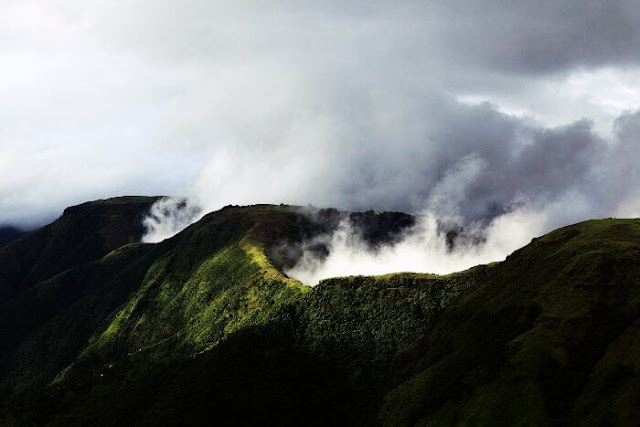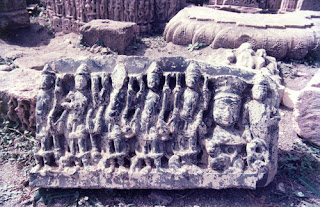Foggy, dirtied Wednesday morning for Delhi-NCR, yet there's slight change
Ritam Halder and Ashni Dhaor, Hindustan Times, New Delhi/Noida/Gurgaon | Updated: Nov 04, 2016 14:28 IST
Suburbanites in New Delhi, which is secured with thick exhaust cloud as contamination hits unsafe levels on Wednesday. (PTI)
Individuals in Delhi and national capital area urban communities of Noida, Ghaziabad and Gurgaon woke up to murky conditions with no sight of the sun till 11:30am.
Contamination control office authorities said the dim condition was because of brown haze - an aftereffect of contamination and in addition clean noticeable all around - however the circumstance was marginally superior to the most recent two days and even enhanced a bit interestingly since Diwali.
As per authorities from the provincial contamination control board, stubble blazing in neighboring conditions of Haryana and Punjab is additionally adding to the exhaust cloud in Delhi and the NCR.
"Post Diwali we see a significant ascent in contamination because of evident reasons (blasting of wafers). In any case, that is by all account not the only explanation behind the smoggy conditions in the city as tidy particles are additionally a noteworthy purpose for it," said Paras Nath, territorial supervisor, UP Pollution Control Board, Ghaziabad.
"Trim blazing is going ahead in neighboring states which have additionally added to exhaust cloud in the city. As the winter season is drawing closer, these particles tend to remain noticeable all around adding to the smoggy conditions," Nath included.
Starting 11am on Wednesday, PM10 (particulate matter 10 micrometers or less in distance across) achieved 743µg/m³ (microgram per cubic meter) while PM2.5 touched 561µg/m³ at Mandir Marg. At Punjabi Bagh, PM2.5 timed 887µg/m³ while at Anand Vihar it was as much as 460µg/m³.
The recommended principles of PM 2.5 and PM 10 are 60 and 100 individually and anything past that can hurt the respiratory framework as the ultra fine particulates can insert profound into the lungs furthermore enter the circulation system.
On Wednesday, the base temperature in Noida and Ghaziabad dropped to 16 degree Celsius and the most extreme was 32 degree Celsius. The meteorologist recorded the base temperature at 17 degrees Celsius, and the greatest temperature stayed around 30 degrees in Gurgaon.
In Gurgaon, the base temperature in the city has seen an estimated drop of four degrees in the previous week and occupants have begun to feel the chill noticeable all around.
Advertisements by ZINC
"The persistent stream of dry and cool north-westerly winds have likewise prompted to a moderate change in temperature. In any case, there will be a steady drop in night temperatures as the winter season is likewise around the bend," RK Jenamani, chief accountable for meteorological office at IGI Airport, said.
As indicated by Met office authorities, perceivability in Delhi-NCR stayed between 300 to 400 meters, which is considered remarkably poor as for the temperature that is not that low.
"As there is a block in daylight, the climate is required to stay lovely amid mornings and nighttimes," Jenamani said.
As schools and workplaces in Noida and Ghaziabad revived on Wednesday after the Diwali break, suburbanites had an intense time traveling to the working environment in the midst of the thick brown haze.
"I needed to utilize stopping lights while driving as the perceivability was perilously low. I was likewise amazingly wary while driving in the morning at 7am which additionally brought about me getting late for office," Abhishek Rathi, an inhabitant of Indirapuram, said.
Suburbanites on the National Highway in Gurgaon were additionally influenced as they needed to drive gradually to maintain a strategic distance from mischances.
"It took me over 30 minutes to achieve my office in Cyber Hub from Gurgaon's Sector 45. Typically, it takes 15 to 20 minutes on any offered day to cover this separation. The climate is not clear," Mohit Sharma, a corporate representative, said.
Firecrackers on Diwali pushed contamination in Delhi to a perilous level, the most exceedingly awful in three years. It turned the air profoundly lethal because of a fatal mixed drink of hurtful respirable poisons and gasses, overwhelming the city with a front of thick brown haze that activated wellbeing alerts.
Different checking organizations, including Delhi Pollution Control Committee, Central Pollution Control Board and Center for Science and Environment other than Pune-based SAFAR, were consistent about the seriousness of the air quality in the Capital this Diwali.
The city of 20 million individuals, which positions among the world's top urban areas with foul air on a World Health Organization list, has been attempting to clean its air that contains a harmful mixed drink of tidy, smoke and gasses from vehicle, production line depletes and coal-terminated power stations.
Ritam Halder and Ashni Dhaor, Hindustan Times, New Delhi/Noida/Gurgaon | Updated: Nov 04, 2016 14:28 IST
Suburbanites in New Delhi, which is secured with thick exhaust cloud as contamination hits unsafe levels on Wednesday. (PTI)
Individuals in Delhi and national capital area urban communities of Noida, Ghaziabad and Gurgaon woke up to murky conditions with no sight of the sun till 11:30am.
Contamination control office authorities said the dim condition was because of brown haze - an aftereffect of contamination and in addition clean noticeable all around - however the circumstance was marginally superior to the most recent two days and even enhanced a bit interestingly since Diwali.
As per authorities from the provincial contamination control board, stubble blazing in neighboring conditions of Haryana and Punjab is additionally adding to the exhaust cloud in Delhi and the NCR.
"Post Diwali we see a significant ascent in contamination because of evident reasons (blasting of wafers). In any case, that is by all account not the only explanation behind the smoggy conditions in the city as tidy particles are additionally a noteworthy purpose for it," said Paras Nath, territorial supervisor, UP Pollution Control Board, Ghaziabad.
"Trim blazing is going ahead in neighboring states which have additionally added to exhaust cloud in the city. As the winter season is drawing closer, these particles tend to remain noticeable all around adding to the smoggy conditions," Nath included.
Starting 11am on Wednesday, PM10 (particulate matter 10 micrometers or less in distance across) achieved 743µg/m³ (microgram per cubic meter) while PM2.5 touched 561µg/m³ at Mandir Marg. At Punjabi Bagh, PM2.5 timed 887µg/m³ while at Anand Vihar it was as much as 460µg/m³.
The recommended principles of PM 2.5 and PM 10 are 60 and 100 individually and anything past that can hurt the respiratory framework as the ultra fine particulates can insert profound into the lungs furthermore enter the circulation system.
On Wednesday, the base temperature in Noida and Ghaziabad dropped to 16 degree Celsius and the most extreme was 32 degree Celsius. The meteorologist recorded the base temperature at 17 degrees Celsius, and the greatest temperature stayed around 30 degrees in Gurgaon.
In Gurgaon, the base temperature in the city has seen an estimated drop of four degrees in the previous week and occupants have begun to feel the chill noticeable all around.
Advertisements by ZINC
"The persistent stream of dry and cool north-westerly winds have likewise prompted to a moderate change in temperature. In any case, there will be a steady drop in night temperatures as the winter season is likewise around the bend," RK Jenamani, chief accountable for meteorological office at IGI Airport, said.
As indicated by Met office authorities, perceivability in Delhi-NCR stayed between 300 to 400 meters, which is considered remarkably poor as for the temperature that is not that low.
"As there is a block in daylight, the climate is required to stay lovely amid mornings and nighttimes," Jenamani said.
As schools and workplaces in Noida and Ghaziabad revived on Wednesday after the Diwali break, suburbanites had an intense time traveling to the working environment in the midst of the thick brown haze.
"I needed to utilize stopping lights while driving as the perceivability was perilously low. I was likewise amazingly wary while driving in the morning at 7am which additionally brought about me getting late for office," Abhishek Rathi, an inhabitant of Indirapuram, said.
Suburbanites on the National Highway in Gurgaon were additionally influenced as they needed to drive gradually to maintain a strategic distance from mischances.
"It took me over 30 minutes to achieve my office in Cyber Hub from Gurgaon's Sector 45. Typically, it takes 15 to 20 minutes on any offered day to cover this separation. The climate is not clear," Mohit Sharma, a corporate representative, said.
Firecrackers on Diwali pushed contamination in Delhi to a perilous level, the most exceedingly awful in three years. It turned the air profoundly lethal because of a fatal mixed drink of hurtful respirable poisons and gasses, overwhelming the city with a front of thick brown haze that activated wellbeing alerts.
Different checking organizations, including Delhi Pollution Control Committee, Central Pollution Control Board and Center for Science and Environment other than Pune-based SAFAR, were consistent about the seriousness of the air quality in the Capital this Diwali.
The city of 20 million individuals, which positions among the world's top urban areas with foul air on a World Health Organization list, has been attempting to clean its air that contains a harmful mixed drink of tidy, smoke and gasses from vehicle, production line depletes and coal-terminated power stations.






















































